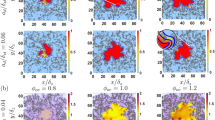Abstract
Analytical expressions for mass concentration of liquid fuel in a spray are derived taking into account the effects of gas turbulence, and assuming that the influence of droplets on gas is small (intitial stage of spray development). Beyond a certain distance the spray is expected to be fully dispersed. This distance is identified with the maximum spray penetration. Then the influence of turbulence on the spray stopping distance is discussed and the rms spray penetration is computed from a trajectory (Lagrangian) approach. Finally, the problem of spray penetration is investigated in a homogeneous two-phase flow regime taking into account the dispersion of spray away from its axis. It is predicted that for realistic values of spray parameters the spray penetration at large distances from the nozzle is expected to be proportional to t 2/3 (in the case when this dispersion is not taken into account this distance is proportional to t 1/2). The t 2/3 law is supported by experimental observations for a high pressure injector.
Similar content being viewed by others
References
Crowe, C.T., Review-Numerical models for dilute gas-particle flows. ASME J. Fluids Engrg. 104 (1982) 297-303.
Crowe, C.T., On models for turbulence modulation in fluid-particle flows. Internat. J. Multiphase Flow 26 (2000) 719-727.
Stock, D.E., Particle dispersion in flowing gases. ASME J. Fluids Engrg. 118 (1996) 4-17.
Lefebvre, A., Atomization and Sprays. Taylor and Francis, Washington (1989).
Rietz, R. and Krieger, R. (eds), Fuel Spray Studies. Society of Automotive Engineers, Warrendale, PA (1997).
Siebers, D.L., Liquid-phase fuel penetration in Diesel sprays. SAE Technical Report 980809 (1998).
Siebers, D.L., Scaling liquid-phase fuel penetration in Diesel sprays based on mixing-limited vaporization. SAE Technical Report 1999-01-0528 (1999).
Sazhin, S.S., Feng, G. and Heikal, M.R., A model for spray penetration. Fuel 80(15) (2001) 2171-2180.
Savich, S., Spray dynamics and in-cylinder air motion. Ph.D. Thesis, The University of Brighton (2001).
Simonin, O., Deutsch, E. and Minier, J.-P., Eulerian prediction of the fluid/particle correlated motion in turbulent two-phase flows. Appl. Sci. Res. 51 (1993) 275-283.
Csanady G.T., Turbulent Diffusion in the Environment. D. Reidel, Dordrecht (1973).
Minier, J.-P. and Peirano, E., The PDF approach to turbulent polydispersed two-phase flows. Phys. Rep. 352 (2001) 1-214.
Maxey, M.R. and Riley, J.J., Equation of motion for a small rigid sphere in a nonuniform flow. Phys. Fluids 26 (1983) 883-889.
Pozorski, J. and Minier, J.-P., PDF modeling of dispersed two-phase turbulent flows. Phys. Rev. E 59 (1999) 855-863.
Pozorski, J., Numerical simulation of dispersed phase motion in turbulent two-phase flow. Doctoral Thesis, Institute of Fluid-Flow Machinery, Polish Academy of Sciences, Gda´nsk (1995).
Ghosh, S. and Hunt, J.C.R., Induced air velocity within droplet driven sprays. Proc. Roy. Soc. London A 444 (1994) 105-127.
Pope, S.B., Lagrangian PDF methods for turbulent flows. Ann. Rev. Fluid Mech. 26 (1994) 23-63.
Pozorski, J. and Minier, J.-P., On the Lagrangian turbulent dispersion models based on the Langevin equation. Internat J. Multiphase Flow 24 (1998) 913-945.
Eaton, J.K. and Fessler, J.R., Preferential concentration of particles by turbulence. Internat. J. Multiphase Flow 20 (1994) 169-209.
Hainaux, F., Aliseda, A., Cartellier, A. and Lasheras, J.C., Settling velocity and clustering of particles in an homogeneous and isotropic turbulence. In: Dopazo, C. (ed.), Advances in Turbulence VIII. CIMNE (International Center for Numerical Methods in Engineering), Barcelona (2000) pp. 553-556.
Dávila, J. and Hunt, J.C.R., Settling of small particles near vortices and in turbulence. J. Fluid Mech. 440 (2001) 117-145.
Maxey, M.R., The motion of small spherical particles in a cellular flow field. Phys. Fluids 30 (1987) 1915-1928.
Maxey, M.R., The gravitational settling of aerosol particles in homogeneous turbulence and random flow fields. J. Fluid Mech. 174 (1987) 441-465.
Wang, L.P. and Maxey, M.R., Settling velocity and concentration distribution of heavy particles in homogeneous isotropic turbulence. J. Fluid Mech. 256 (1993) 27-68.
Naber, J.D. and Siebers, D.L., Effects of gas density and vaporization on penetration and dispersion of diesel sprays. SAE Report 960034 (1996).
Author information
Authors and Affiliations
Rights and permissions
About this article
Cite this article
Pozorski, J., Sazhin, S., Wacławczyk, M. et al. Spray Penetration in a Turbulent Flow. Flow, Turbulence and Combustion 68, 153–165 (2002). https://doi.org/10.1023/A:1020497028986
Issue Date:
DOI: https://doi.org/10.1023/A:1020497028986




